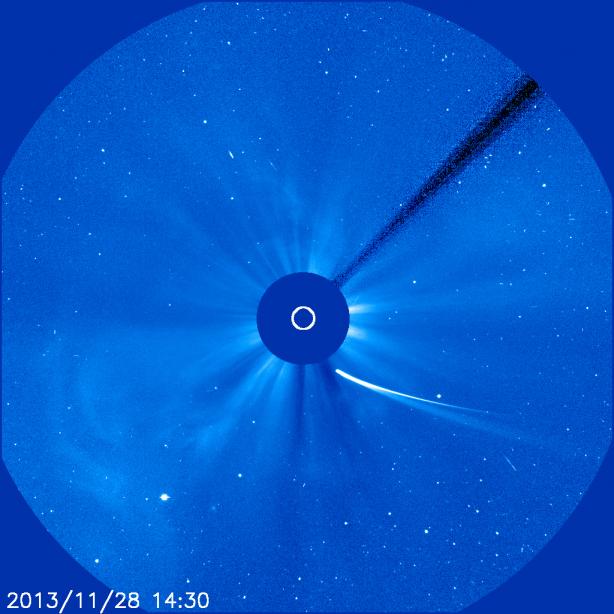COMET ISON T – 3 HOURS FROM PERIHELION
2013-Nov-28
The ups-and-downs of ISON continue. After experiencing a large outburst yesterday, the comet actually appears to be fading now. If Karl Battams estimate of magnitude -1 from this morning is correct, then the comet has faded intrinsically by almost 3 magnitudes from yesterday. Whether the fading is due to the end of yesterday’s outburst or the final disintegration of the comet is still not known. Joe Marcus provided another possible explanation in CBET 3723. He forecast that at ISON’s current distance and closer, sub-micron sized dust grains will literally be vaporized by the intense solar heat. Similar to what was seen with the last good sun-grazer C/2011 W3 (Lovejoy), ISON may fade as the Sun erodes its coma until it is once again 0.03-0.04 AU from the Sun.
Only time will tell and likely we can all watch. The best view is from the SOHO LASCO C2 imagers at http://sohowww.nascom.nasa.gov/data/realtime/c2/1024/latest.html . A European mirror site can be found here (it appears to be a few hours behind the NASA site): http://soho.esac.esa.int/data/realtime/c2/1024/latest.html .
The image below was taken with the LASCO C3 imager on the NASA/ESA SOHO spacecraft. It vividly shows the two dust tails that ISON has produced. According to Zdenek Sekanina (JPL) (also in CBET 3723), the broad but fainter tail is dust released since the major November 14 outburst while the bright thin streamer is composed of larger particles that were released by the comet over the past few years. Some of these particles may have been released as far out as 20 AU from the Sun.
- Carl Hergenrother (Acting Co-coordinator of ALPO Comet Section)




